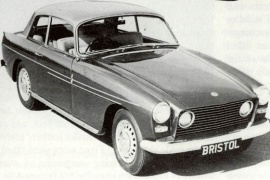BRISTOL 408 Models/Series Timeline, Specifications & Photos
First production year: 1963
Engines: Gasoline
Body style: Coupé (two-door)
The British automaker Bristol introduced the 408 model as a successor to the 407 series in 1963, followed by the 408 Mark II in 1965.
While facelifts were not an exact science in those times, the British carmaker understood that refreshed models could lead to more significant sales. Moreover, the introduction of a new nameplate, even if it sported most of the previous model's features, was also healthy for its budget.
Unlike the 407, the 408 lineup featured flatter body panels, which were more attractive and cheaper to build. In addition to the car's main headlights, the automaker included a pair of lamps on the redesigned flat radiator grille. Another improvement over the 407 was the introduction of rectangular blinkers and parking lights. These were placed on the front's sides, above the chromed bumper. However, the car's profile still resembled its predecessor, with a two-door sedan shape and generous rear windows. At the back, the long trunk allowed occupants to carry enough luggage for longer trips.
The cabin was just as luxurious as expected from a Bristol. Its leather-wrapped and comfortable front bucket seats were highly appreciated on long travels. In addition, the drivers praised the instrument panel, which sported a design inspired by former fighter bombers from WWII. The bench was fit for two passengers at the back, even for longer trips. Yet, the legroom was not exactly generous.
Under the hood, Bristol installed the same 5.2-liter V8 previously installed in the 407. It was a modified version of a Chrysler powerplant. It was paired with a three-speed automatic transmission known as TorqueFlite.
